I’ve played around with a few DJI drones over the years but always found them to be too cumbersome to master and use spontaneously. The $349 HoverAir X1 from Zero Zero Robotics is different. This so-called “selfie drone” is so easy to use that it’s already an indispensable tool for my work and play, right out of the box.
Technology
The HoverAir X1 is the first drone I want to use all the time
/cdn.vox-cdn.com/uploads/chorus_asset/file/25556630/IMG_8670.jpeg)
For example, the HoverAir X1 is responsible for this review photo, this 360-degree GIF, and this overhead shot, as well as all of the follow, orbit, and zoom in / out shots used in this e-bikepacking video and this ID Buzz e-camper review. Each shot was made with just a touch of a button on the top of the drone — no controller required.
The best drone is the one you have with you and the ultra-lightweight HoverAir X1 can easily fit inside a pocket to be taken everywhere. It launches so quickly that I can impulsively grab a more interesting drone shot instead of just defaulting to my iPhone. It returns automatically to land in your hand.
The HoverAir X1 is not without limitations, and I did manage to break one review unit after falling on it. But I have to admit I love this little guy precisely because of its shortcomings, not in spite of them.
The HoverAir X1’s flying weight is about half that of DJI’s sub-250g Mini drones, so it, too, is exempt from registration and licensing requirements in most countries. It folds up into a 5 x 3.4 x 1.2-inch (127 x 86 x 31mm) package that’s so small and lightweight that I could comfortably carry it in a thigh pocket on long bike rides or trail runs.
The primary user interface for the X1 is two buttons on the drone itself. One turns the unit on, and the other cycles through five presets that lock the camera onto the user as the drone completes a predetermined flight path, shooting video or taking photos along the way:
- Hover — floats in fixed space and tracks your movement
- Follow — flies behind or in front of you at different heights and distances
- Orbit — makes a wide circle overhead around a fixed center spot
- Zoom out — flies away and up and then back in
- Bird’s eye — for top-down shots directly over a fixed spot
There’s also a sixth mode that lets you assign a lightly customized flight pattern. The hover and follow modes can record videos or take photos for several minutes at a time, while the other flight modes begin and end at the point of launch and last for about 30 seconds.
The HoverAir app lets you tweak each of its automatic flight modes, including the altitude, distance, swapping between photo or video captures, portrait or landscape, and image quality. After some early experimentation to see what I liked, I rarely had to adjust these again.
In a metric I like to call “time to drone,” I can pull the X1 out of a pocket, unfold it, turn it on, select a predefined flight path, and set it aloft from an outstretched palm in less than 20 seconds. No DJI drone can come anywhere close.
That’s not to say that the HoverAir can compete with DJI’s consumer drones on features or capabilities. The X1’s diminutive size means compromises were made, starting with a max video resolution of 2.7K/30fps.
Shots also start looking a little shaky in light winds around 10 knots (5.1m/s), and the X1 can’t even fly once winds exceed a moderate 15 knots (7.7m/s). It’s also relatively slow. The X1 can track me fine on a trail run, but it’ll start losing its object lock when I’m road biking at a not-very-fast pace of just 12mph (20km/h). Even when it can keep up, it’ll lose me when the elevation changes rapidly on a steep climb or descent.
Otherwise, the X1’s computer vision tracking is very good — it’s the main reason you’d buy this drone. But when it does lose track of me for whatever reason, it’ll just stop, hover in place, and then eventually land, even over water or a busy street. There is no return-to-home feature to ensure a safe landing and recovery. It can, however, be configured to play a sound to help find it.
The X1 also lacks any obstacle avoidance. Instead, the drone’s four rotors are encased in a flexible plastic cage to protect the device from collisions. In most flight modes, the lack of avoidance tech isn’t really a problem so long as you give the immediate area a quick survey. It becomes an issue when the drone is in follow-me mode through narrow tree-lined trails, for example, or when walking around a sharp corner inside my home. Usually, it’ll just stop and hover in place if it runs into something, meaning I’ll have to double back to re-engage the tracking lock on my person or to collect it. But if it hits something when going faster — like chasing me on a bike — it’ll crash. My review X1 has already survived a few dozen crashes that sent it plummeting to the ground. It’s fine, other than a few scuff marks.
I did destroy another X1 when my full weight landed on it while testing some new clipless bike pedals (don’t judge!). The X1 is not indestructible, but it’s surprisingly robust for such a lightweight drone.
1/10
The HoverAir X1 also lacks any kind of advanced GPS positioning. Instead, it opts for a VIO (Visual Inertial Odometry) system to estimate its position in 3D space, indoors or out, so that its preset flight modes can return the drone to its original starting point. It worked very well in my testing, often living up to the HoverAir’s claim of “centimeter-level precision,” even when flying orbits around me with a 20-foot (six-meter) radius.
The drone also responds to a variety of hand gestures when the user is standing still. For example, you can send the X1 left or right with a wave of an arm or tell it to land with your arms crossed overhead. You can also just grab the drone out of the air and flip it upside down to turn those protected rotors off.
The HoverAir X1 does offer a manual Wi-Fi-connected flight mode whereby your phone becomes the controller. It’s fun, but I found it unresponsive at times, making it difficult to control flight with any real precision. I consider it a bonus feature you might want to use in a pinch.
The X1 is limited to 32GB of built-in storage without any option for microSD expansion. I’m currently using just 8.8GB to store the 113 videos and 60 images I’ve shot at max resolution over the last few months of testing. The footage transfers quickly to a phone over a direct Wi-Fi connection using the HoverAir app or over USB-C to a laptop. That USB-C connection will also charge the X1’s battery in about 55 minutes.
On paper, the X1 is dumb and unremarkable. But the HoverAir is so good at doing what many people actually need from a drone that its shortcomings rarely matter at all.
DJI is still the king of sweeping panoramas, but the HoverAir X1 makes a strong case for being the drone you choose to capture yourself doing things — indoors and out — especially for social media.
I do wish it was more capable so I could trust it to capture action over water when kitesurfing on windy days, keep up with me when road cycling at pace, or maintain its object lock when I’m bombing down a steep hill on a mountain bike. A 4K/60fps shooting mode would also be nice so long as none of these wishes increase the price too much.
The X1 does 90 percent of what I want a drone to do
Still, the X1 does 90 percent of what I want a drone to do without adding GPS, obstacle avoidance sensors, and a physical controller that’ll just make everything more expensive, more complicated, more cumbersome to carry, and slower to launch. Maybe DJI’s rumored Neo will fill in that last 10 percent because it certainly looks like a response to the HoverAir hype.
The HoverAir X1 lists for $429, but it’s nearly always on sale somewhere, often at or below $350. But I’d recommend opting for the $400-ish bundle that adds a dual-battery quick charger and two extra batteries that each only last about 10 to 12 minutes before needing a 35-minute recharge. Like the X1 itself, they’re so small and lightweight that you can easily bring them along to help document your next activity.
All photography by Thomas Ricker / The Verge

Technology
Inside Mark Zuckerberg’s AI hiring spree

AI researchers have recently been asking themselves a version of the question, “Is that really Zuck?”
As first reported by Bloomberg, the Meta CEO has been personally asking top AI talent to join his new “superintelligence” AI lab and reboot Llama. His recruiting process typically goes like this: a cold outreach via email or WhatsApp that cites the recruit’s work history and requests a 15-minute chat. Dozens of researchers have gotten these kinds of messages at Google alone.
For those who do agree to hear his pitch (amazingly, not all of them do), Zuckerberg highlights the latitude they’ll have to make risky bets, the scale of Meta’s products, and the money he’s prepared to invest in the infrastructure to support them. He makes clear that this new team will be empowered and sit with him at Meta’s headquarters, where I’m told the desks have already been rearranged for the incoming team.
Most of the headlines so far have focused on the eye-popping compensation packages Zuckerberg is offering, some of which are well into the eight-figure range. As I’ve covered before, hiring the best AI researcher is like hiring a star basketball player: there are very few of them, and you have to pay up. Case in point: Zuckerberg basically just paid 14 Instagrams to hire away Scale AI CEO Alexandr Wang.
It’s easily the most expensive hire of all time, dwarfing the billions that Google spent to rehire Noam Shazeer and his core team from Character.AI (a deal Zuckerberg passed on). “Opportunities of this magnitude often come at a cost,” Wang wrote in his note to employees this week. “In this instance, that cost is my departure.”
Zuckerberg’s recruiting spree is already starting to rattle his competitors. The day before his offer deadline for some senior OpenAI employees, Sam Altman dropped an essay proclaiming that “before anything else, we are a superintelligence research company.” And after Zuckerberg tried to hire DeepMind CTO Koray Kavukcuoglu, he was given a larger SVP title and now reports directly to Google CEO Sundar Pichai.
I expect Wang to have the title of “chief AI officer” at Meta when the new lab is announced. Jack Rae, a principal researcher from DeepMind who has signed on, will lead pre-training. Meta certainly needs a reset. According to my sources, Llama has fallen so far behind that Meta’s product teams have recently discussed using AI models from other companies (although that is highly unlikely to happen). Meta’s internal coding tool for engineers, however, is already using Claude.
While Meta’s existing AI researchers have good reason to be looking over their shoulders, Zuckerberg’s $14.3 billion investment in Scale is making many longtime employees, or Scaliens, quite wealthy. They were popping champagne in the office this morning.
Then, Wang held his last all-hands meeting to say goodbye and cried. He didn’t mention what he would be doing at Meta. I expect his new team will be unveiled within the next few weeks after Zuckerberg gets a critical number of members to officially sign on.
Apple is accustomed to being on top of the tech industry, and for good reason: the company has enjoyed a nearly unrivaled run of dominance.
After spending time at Apple HQ this week for WWDC, I’m not sure that its leaders appreciate the meteorite that is heading their way. The hubris they display suggests they don’t understand how AI is fundamentally changing how people use and build software.
Heading into the keynote on Monday, everyone knew not to expect the revamped Siri that had been promised the previous year. Apple, to its credit, acknowledged that it dropped the ball there, and it sounds like a large language model rebuild of Siri is very much underway and coming in 2026.
The AI industry moves much faster than Apple’s release schedule, though. By the time Siri is perhaps good enough to keep pace, it will have to contend with the lock-in that OpenAI and others are building through their memory features. Apple and OpenAI are currently partners, but both companies want to ultimately control the interface for interacting with AI, which puts them on a collision course.
Apple’s decision to let developers use its own, on-device foundational models for free in their apps sounds strategically smart, but unfortunately, the models look far from leading. Apple ran its own benchmarks, which aren’t impressive, and has confirmed a measly context window of 4,096 tokens. It’s also saying that the models will be updated alongside its operating systems — a snail’s pace compared to how quickly AI companies move.
I’d be surprised if any serious developers use these Apple models, although I can see them being helpful to indie devs who are just getting started and don’t want to spend on the leading cloud models. I don’t think most people care about the privacy angle that Apple is claiming as a differentiator; they are already sharing their darkest secrets with ChatGPT and other assistants.
Some of the new Apple Intelligence features I demoed this week were impressive, such as live language translation for calls. Mostly, I came away with the impression that the company is heavily leaning on its ChatGPT partnership as a stopgap until Apple Intelligence and Siri are both where they need to be.
AI probably isn’t a near-term risk to Apple’s business. No one has shipped anything close to the contextually aware Siri that was demoed at last year’s WWDC. People will continue to buy Apple hardware for a long time, even after Sam Altman and Jony Ive announce their first AI device for ChatGPT next year. AR glasses aren’t going mainstream anytime soon either, although we can expect to see more eyewear from Meta, Google, and Snap over the coming year.
In aggregate, these AI-powered devices could begin to siphon away engagement from the iPhone, but I don’t see people fully replacing their smartphones for a long time. The bigger question after this week is whether Apple has what it takes to rise to the occasion and culturally reset itself for the AI era.
I would have loved to hear Tim Cook address this issue directly, but the only interview he did for WWDC was a cover story in Variety about the company’s new F1 movie.
- AI agents are coming. I recently caught up with Databricks CEO Ali Ghodsi ahead of his company’s annual developer conference this week in San Francisco. Given Databricks’ position, he has a unique, bird’s-eye view of where things are headed for AI. He doesn’t envision a near-term future where AI agents completely automate real-world tasks, but he does predict a wave of startups over the next year that will come close to completing actions in areas such as travel booking. He thinks humans will need (and want) to approve what an agent does before it goes off and completes a task. “We have most of the airplanes flying automated, and we still want pilots in there.”
- Buyouts are the new normal at Google. That much is clear after this week’s rollout of the “voluntary exit program” in core engineering, the Search organization, and some other divisions. In his internal memo, Search SVP Nick Fox was clear that management thinks buyouts have been successful in other parts of the company that have tried them. In a separate memo I saw, engineering exec Jen Fitzpatrick called the buyouts an “opportunity to create internal mobility and fresh growth opportunities.” Google appears to be attempting a cultural reset, which will be a challenging task for a company of its size. We’ll see if it can pull it off.
- Evan Spiegel wants help with AR glasses. I doubt that his announcement that consumer glasses are coming next year was solely aimed at AR developers. Telegraphing the plan and announcing that Snap has spent $3 billion on hardware to date feels more aimed at potential partners that want to make a bigger glasses play, such as Google. A strategic investment could help insulate Snap from the pain of the stock market. A full acquisition may not be off the table, either. When he was recently asked if he’d be open to a sale, Spiegel didn’t shut it down like he always has, but instead said he’d “consider anything” that helps the company “create the next computing platform.”
If you haven’t already, don’t forget to subscribe to The Verge, which includes unlimited access to Command Line and all of our reporting.
As always, I welcome your feedback, especially if you’re an AI researcher fielding a juicy job offer. You can respond here or ping me securely on Signal.
Technology
AI tennis robot coach brings professional training to players
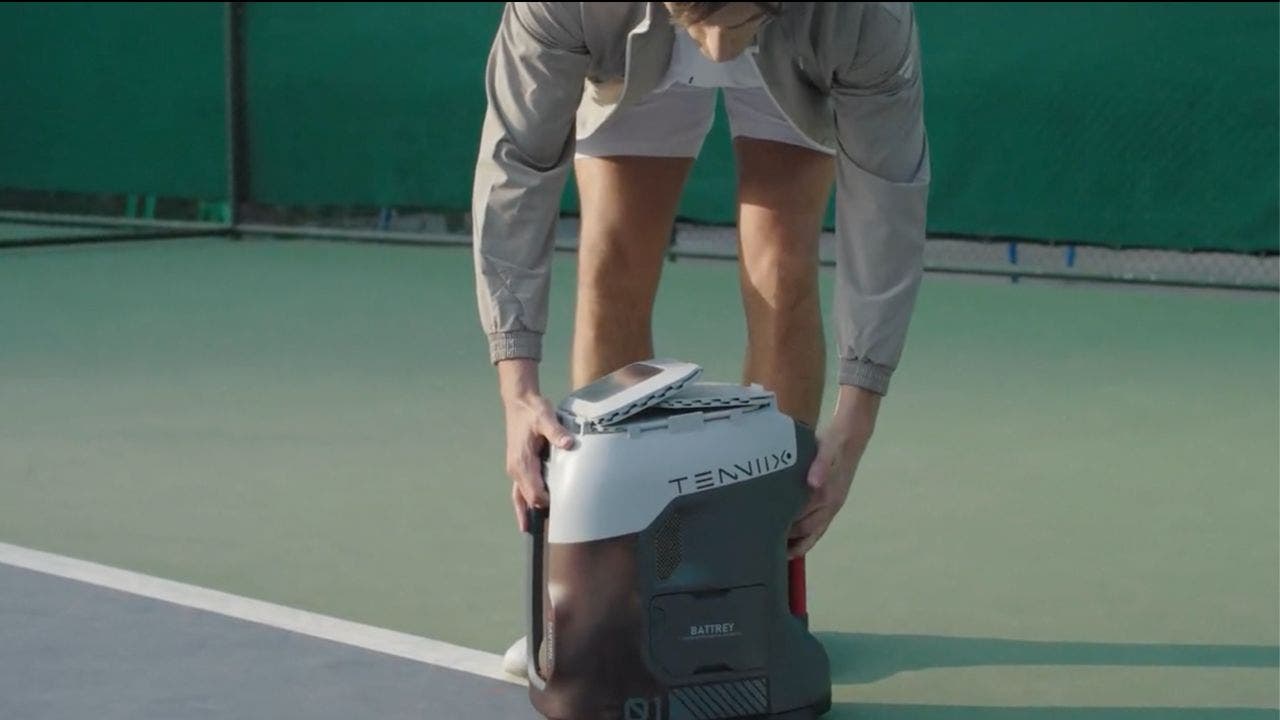
NEWYou can now listen to Fox News articles!
Finding a reliable tennis partner who matches your energy and skill level can be a challenge.
Now, with Tenniix, an artificial intelligence-powered tennis robot from T-Apex, players of all abilities have a new way to practice and improve.
Tenniix brings smart technology and adaptability to your training sessions, making it easier to get the most out of your time on the court.
Sign up for my FREE CyberGuy Report
Get my best tech tips, urgent security alerts and exclusive deals delivered straight to your inbox. Plus, you’ll get instant access to my Ultimate Scam Survival Guide — free when you join.
Tenniix, the AI-powered tennis robot (T-Apex)
What is Tenniix? Meet the AI tennis robot transforming practice sessions
Tenniix is an AI-powered tennis robot that is compact and weighs only 15 pounds, which is much lighter than traditional ball machines. Despite its small size, it serves balls at speeds of up to 75 mph, with spins reaching 5,000 RPM, and holds up to 100 balls at a time. The robot’s movable base allows it to deliver shots from different angles, keeping practice sessions dynamic and engaging.
TENNIS PRO ERIN ROUTLIFFE EXPLODES OVER LACK OF ‘ROBOTS’ AT AUSTRALIAN OPEN
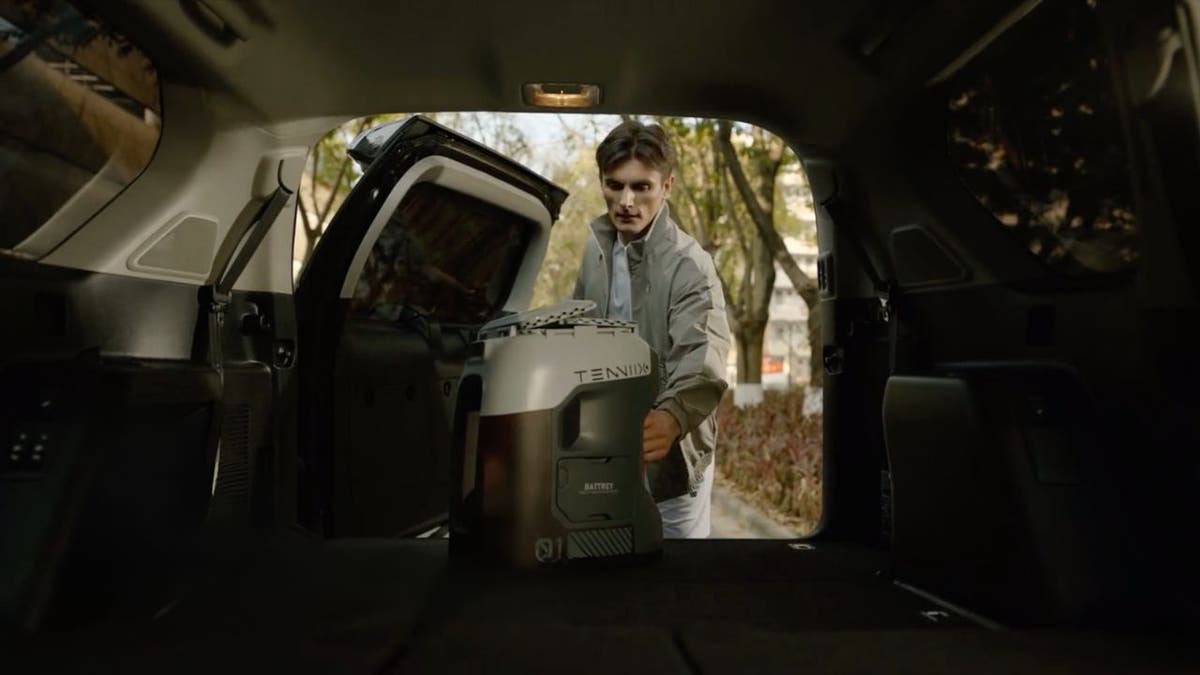
A player lifting the Tenniix, an AI-powered tennis robot, out of the vehicle. (T-Apex)
NO TENNIS PARTNER? NO WORRIES WITH THIS AI ROBOT
AI tennis coaching: How Tenniix delivers realistic, pro-level practice
One of the standout features of Tenniix is its AI-driven coaching. The robot has been trained on over 8,000 hours of professional tennis data, allowing it to adjust its shots based on your position and playing style. This gives you a realistic and challenging experience every time you step on the court. Tenniix offers a wide variety of training modes, with more than 1,000 drills and three skill levels, so you can focus on everything from timing and footwork to shot accuracy.
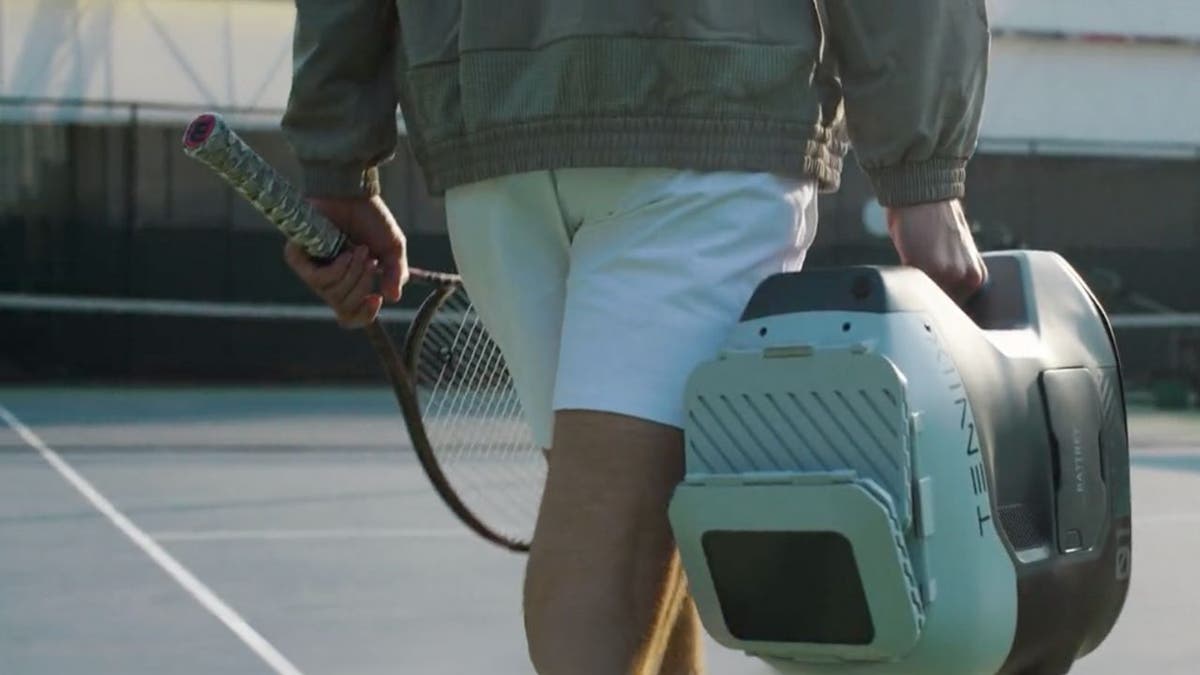
Tenniix, the AI-powered tennis robot being carried (T-Apex)
WILL 3D TECH CHANGE SPORTS FOREVER?
Smart and simple: How to control Tenniix with voice, gestures or your phone
Controlling Tenniix is simple and intuitive. You can use voice commands or gestures to change spin, speed or shot type without interrupting your practice. Tenniix also features convenient app controls, letting you select training modes, adjust settings and review session data right from your smartphone for a fully customized and trackable experience. The robot’s modular design means you can start with the model that fits your needs and upgrade as your skills improve. With a built-in camera and AI chip, Tenniix analyzes your shots and provides instant feedback, helping you track your progress over time.
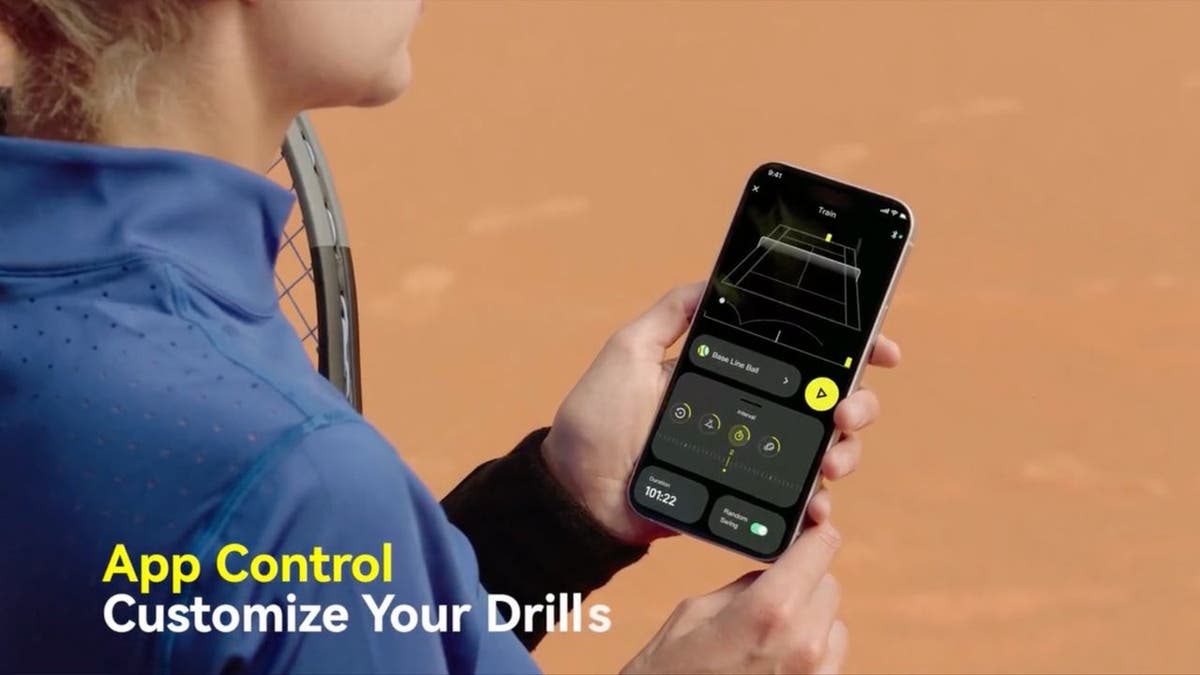
Tenniix, the AI-powered tennis robot (T-Apex)
SKYROCKET TO A HEALTHIER LIFESTYLE WITH THIS GEAR IN 2025
Advanced tracking and movement: How Tenniix adapts to your game in real time
Tenniix uses a combination of visual tracking and ultra-wideband sensors to know exactly where you and the ball are on the court. Its motorized base moves smoothly to deliver a wide range of shots, from high lobs to fast groundstrokes, at different speeds and spins. The battery lasts up to four hours, which is enough for a solid training session.
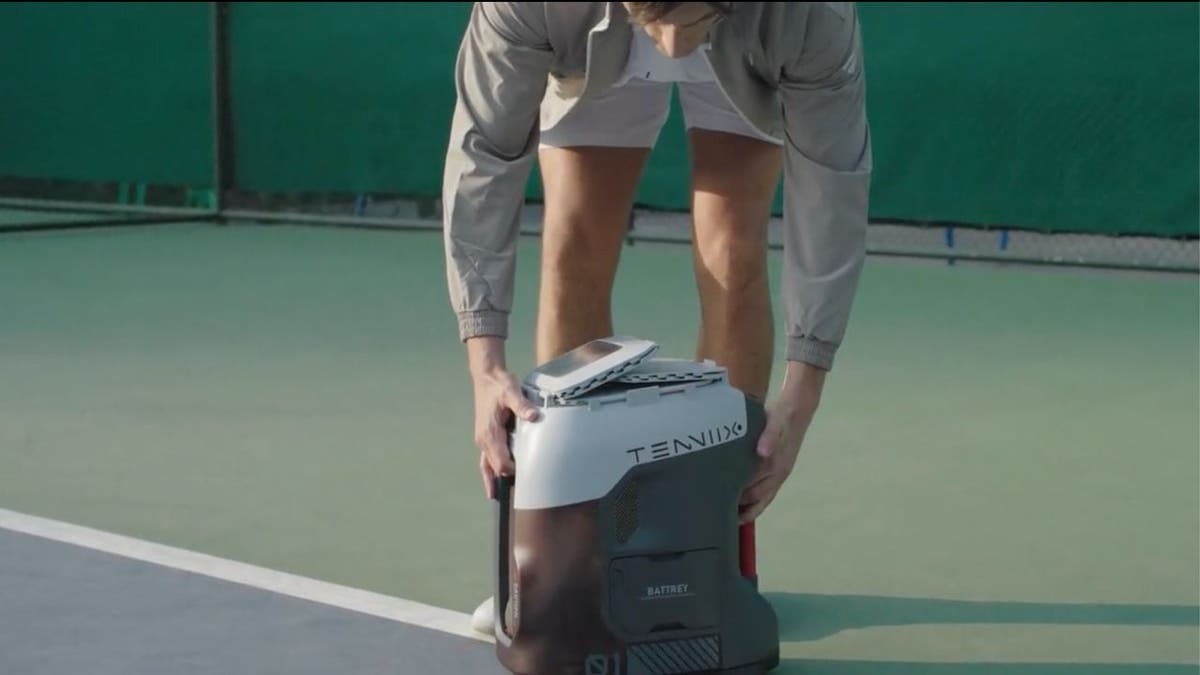
Tenniix, the AI-powered tennis robot (T-Apex)
BEST FATHER’S DAY GIFTS FOR EVERY DAD
Practice like the pros: Train against Nadal-style shots with Tenniix
Another feature that sets Tenniix apart is its ability to mimic the playing styles of tennis greats like Nadal and Federer. This helps you prepare for matches by practicing against shots and spins similar to those you’ll face in real competition. Coaches and players have noted how Tenniix creates realistic rallies and adapts to different skill levels, making training both efficient and enjoyable.
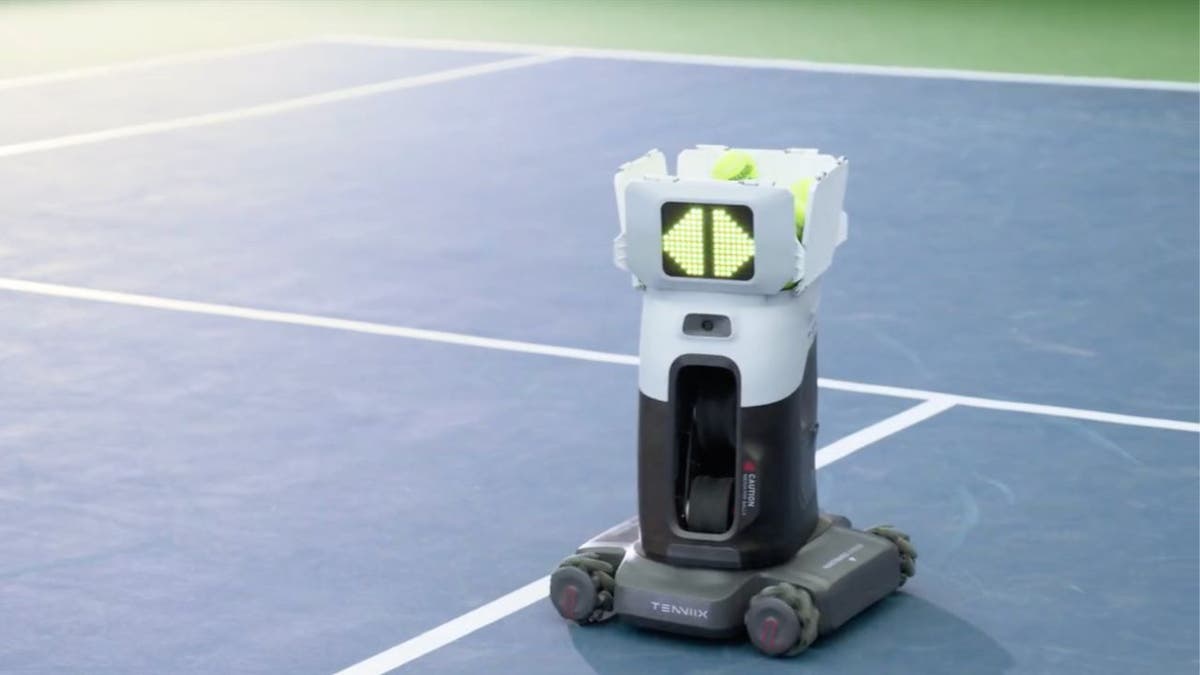
Tenniix, the AI-powered tennis robot (T-Apex)
Portable, smart and backed by support: Why tennis players love Tenniix
Tenniix is easy to carry and set up, making it convenient for players who want to practice anywhere. With thousands of shot combinations and drills, your workouts stay fresh and challenging. The smart technology, real-time tracking and instant feedback help make every session productive. Each robot comes with a one-year warranty and reliable customer service.
WHAT IS ARTIFICIAL INTELLIGENCE (AI)?
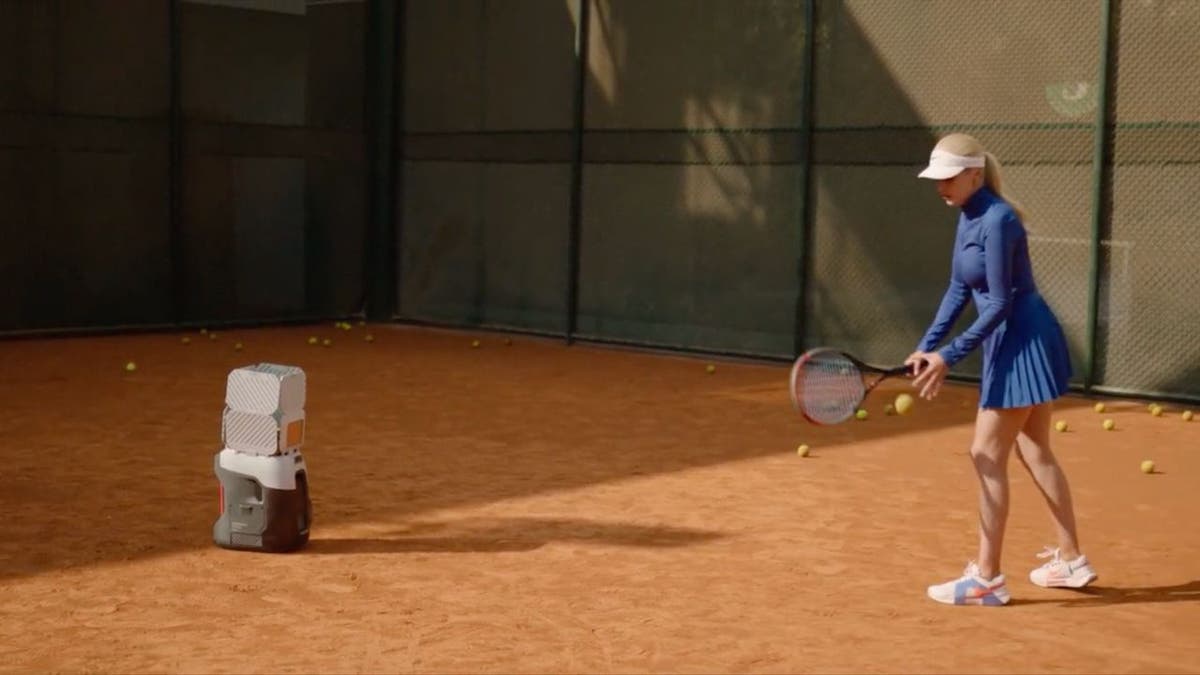
Tenniix, the AI-powered tennis robot (T-Apex)
Tenniix models and pricing: Which AI tennis robot is right for you?
There are three Tenniix models to choose from. The Basic model is priced at $699, the Pro at $999 and the Ultra at $1,499. Each model offers a different set of features, with the Ultra version including advanced options like the movable base and enhanced vision system. Tenniix was launched through a Kickstarter campaign, giving early supporters a chance to back the project and receive the robot at a special price.
SUBSCRIBE TO KURT’S YOUTUBE CHANNEL FOR QUICK VIDEO TIPS ON HOW TO WORK ALL OF YOUR TECH DEVICES
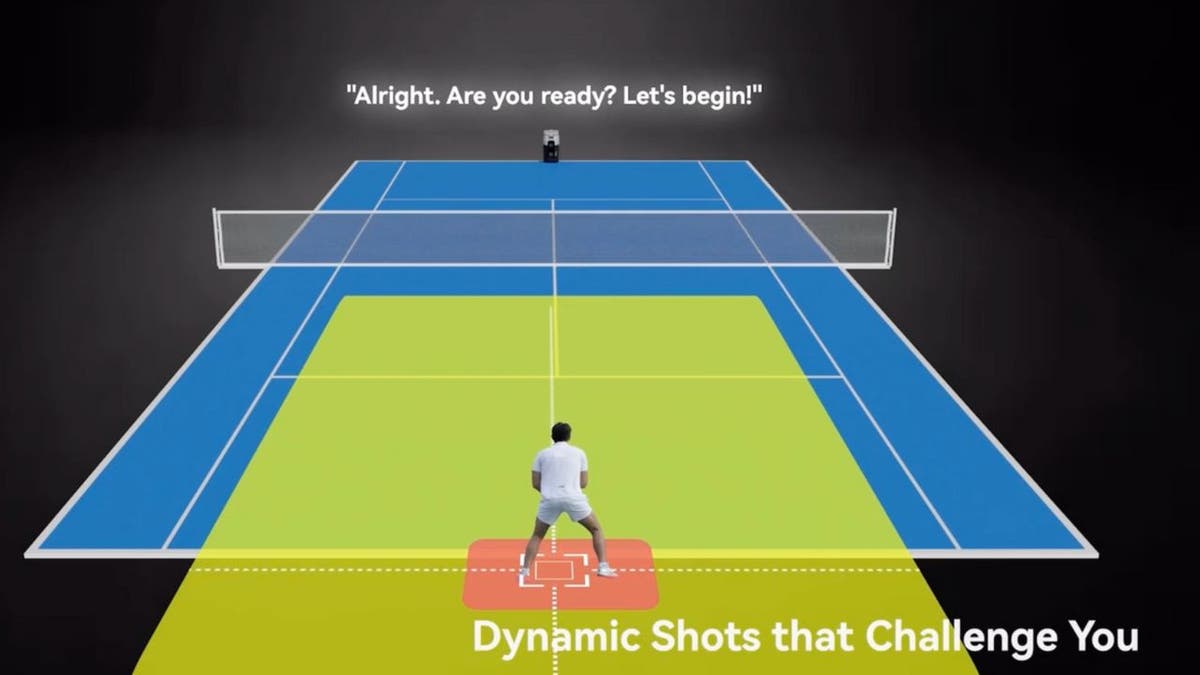
Tenniix, the AI-powered tennis robot (T-Apex)
Kurt’s key takeaways
Tenniix feels less like a machine and more like a smart tennis partner who’s always ready to help you improve. Whether you want to polish your technique or get serious about your game, it offers a flexible and engaging way to train. If you’re looking for a training partner that adapts to you, Tenniix is worth checking out.
Would you rather challenge yourself playing against a robot like Tenniix, or do you prefer training with a human opponent? Let us know by writing us at Cyberguy.com/Contact.
For more of my tech tips and security alerts, subscribe to my free CyberGuy Report Newsletter by heading to Cyberguy.com/Newsletter.
Ask Kurt a question or let us know what stories you’d like us to cover.
Follow Kurt on his social channels:
Answers to the most-asked CyberGuy questions:
New from Kurt:
Copyright 2025 CyberGuy.com. All rights reserved.
Technology
Google is shutting down Android Instant Apps over ‘low’ usage

Google has confirmed that it plans to shut down Android’s Instant Apps later this year, attributing the decision to “low” usage of the functionality.
Instant Apps were introduced in 2017, and allow developers to create mini versions of Android apps that load, well, instantly. Users can try apps and demo games from the click of a link, without having to fully install them. That makes the experience easier for users to navigate and provides developers with more ways to find new audiences.
Android Authority first reported that Google is moving on from the feature, which came to light after developer Leon Omelan spotted a warning about the change in Android Studio:
“Instant Apps support will be removed by Google Play in December 2025. Publishing and all Google Play Instant APIs will no longer work. Tooling support will be removed in Android Studio Otter Feature Drop.”
Google spokesperson Nia Carter confirmed the decision to The Verge, explaining that Instant Apps simply haven’t been popular enough to continue supporting.
“Usage and engagement of Instant Apps have been low, and developers are leveraging other tools for app discovery such as AI-powered app highlights and simultaneous app installs,” Carter says. “This change allows us to invest more in the tools that are working well for developers, and help direct users to full app downloads to foster deeper engagement.”
-

 West1 week ago
West1 week agoBattle over Space Command HQ location heats up as lawmakers press new Air Force secretary
-

 Technology1 week ago
Technology1 week agoiFixit says the Switch 2 is even harder to repair than the original
-

 Technology1 week ago
Technology1 week agoThe single best wireless controller I’ve ever used
-

 Politics1 week ago
Politics1 week agoHawley clashes with UPenn law professor over judicial injunctions
-

 Business1 week ago
Business1 week agoHow Hard It Is to Make Trade Deals
-

 Movie Reviews1 week ago
Movie Reviews1 week agoPredator: Killer of Killers (2025) Movie Review | FlickDirect
-

 Movie Reviews1 week ago
Movie Reviews1 week agoMovie Review: Philippou Brothers' Horrifying 'Bring Her Back' | Seven Days
-

 World1 week ago
World1 week agoMost NATO members endorse Trump demand to up defence spending













